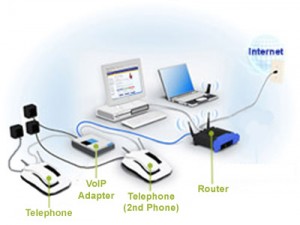 Internet phone service (VoIP) is a strikingly different kind of technology as compared with the traditional telephony. Earlier, landline phone relied on copper wires and analog signals for voice communication. Since then, there have been tremendous advancements in telecommunication technology and the present day phones use the latest internet technology for both incoming and outgoing calls.
Internet phone service (VoIP) is a strikingly different kind of technology as compared with the traditional telephony. Earlier, landline phone relied on copper wires and analog signals for voice communication. Since then, there have been tremendous advancements in telecommunication technology and the present day phones use the latest internet technology for both incoming and outgoing calls.
VoIP converts analog voice signals into digital data packets to facilitate two-way transmission of conversations in real time using the Internet. But, the earliest version of internet phone was a standard phone that used the dialup connection for communicating. There were several teething problems when internet phone technology was first introduced.
The voice quality was dissatisfactory and there were a lot of disturbances. Again, the copper wires were unsuited for transmitting voice data and that led to frequent breakdowns. These initial hiccups constituted a formidable challenge for the internet phone developers. Many believed that internet phone service would end in a fiasco.
Besides, the lack of widespread availability of internet connections also impeded the availability of internet phone service to prospective users. However, with the passage of time and continuing research, internet connections started to improve with the advent of the DSL and other faster data transfer technologies.
The earlier copper wires used for internet were substituted with fiber optic. This replacement improved voice quality and enhanced the overall user experience. Thereafter, several important features were added to internet phone technology.
 Apart from the standard features like caller ID and call forwarding, VoIP has many advanced features such as web mobility, speed dialing, find-me-follow-me, do not disturb, call transfer, toll-free numbers, caller ID blocking, multi-ring facility, area code selection, anonymous call block, distinctive ringing, voice mail and facility for conference calls.
Apart from the standard features like caller ID and call forwarding, VoIP has many advanced features such as web mobility, speed dialing, find-me-follow-me, do not disturb, call transfer, toll-free numbers, caller ID blocking, multi-ring facility, area code selection, anonymous call block, distinctive ringing, voice mail and facility for conference calls.
Large corporations hitherto had an unfair advantage over small and midsize business enterprises and that anomaly has been redressed with the emergence of VoIP. Small and medium-sized businesses can now avail all the benefits of VoIP technology.
VoIP is proving to be a veritable boon to small and mid-sized business houses as they are said to lower overhead costs, improve customer relationship management, enable speedier exchange of information, provide more effective coordination among employees, business associates and customers.
Portability is another key feature of internet phone. You do not have to remain in one place if VoIP phone facility is present.. This is a great benefit for employees stationed outside or on the move. VoIP phone users can use their phone service in three different ways.
Computer Based: Computer based VoIP service needs you to subscribe to an internet phone service and install software on your computer. With this type, you can access the phone service from anywhere in the world. Skype, one of the well known PC-based VoIP services, offers this kind of facility.
VoIP ATA: ATA based VoIP services are the ones which do not require you to have a PC or computer. They instead work through their own piece of equipment called VoIP ATA. For this facility, all you need to do is to connect one end of your VoIP ATA with the internet line and the other end with your phone.
Mobile VoIP: Mobile VoIP, as we all know, works with a wireless internet connection. Mobile VoIP performed reasonably well on the 3G network and this has further improved with the availability of 4G.


































